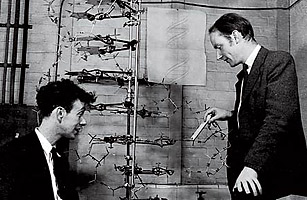
Feb. 28, 1953
James Watson remembers cringing when his colleague Francis Crick announced to regulars at the Eagle, a pub in Cambridge, England, that they had discovered "the secret of life." True, the onetime ornithologist and the former physicist had created a plausible model for the structure of DNA that morning. If they were right, biologists would finally understand how parents pass characteristics on to their children — not only hair and eye color but every aspect of how the human body is built and how it operates. Watson, at left in photo, and Crick would have solved the mysteries of heredity and of evolution, all in one shot.
But they also might have been wrong, as they had been a year and a half earlier, when the two rookies had made some dumb mistakes. Even Linus Pauling, the world's greatest chemist, had blown his own "solution" to DNA a couple of months before. So while their double-helix model seemed to make biochemical sense and agreed with what was already known, a wiser man might have toned down his rhetoric.
The fact that double helix and Watson and Crick are familiar to just about every schoolchild, though, makes it clear that DNA was every bit as important as Crick thought. Not only did it explain heredity, but it would also lead to such practical applications as DNA forensics in law enforcement, testing for genetic diseases and the development of an entire biotechnology industry. With the recent completion of the Human Genome Project, it could radically change the way medicine is practiced over the next few decades. Crick's bold assertion was, if anything, stunningly accurate.